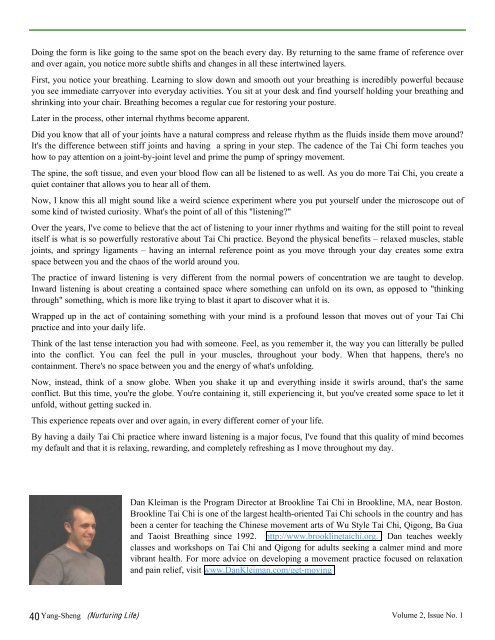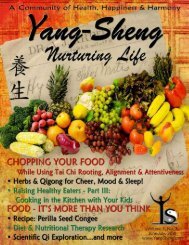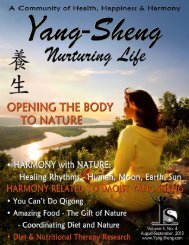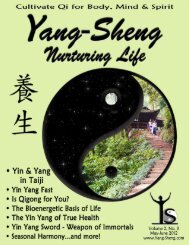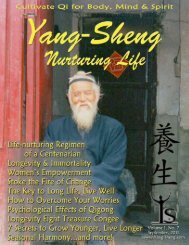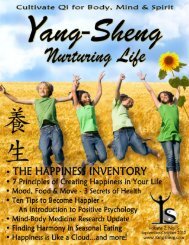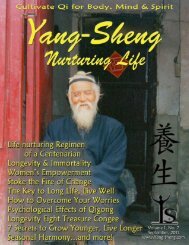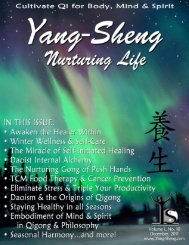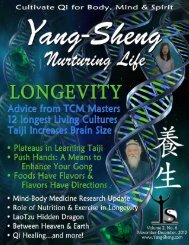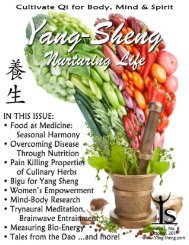Download PDF - Yang-Sheng
Download PDF - Yang-Sheng
Download PDF - Yang-Sheng
You also want an ePaper? Increase the reach of your titles
YUMPU automatically turns print PDFs into web optimized ePapers that Google loves.
Doing the form is like going to the same spot on the beach every day. By returning to the same frame of reference over<br />
and over again, you notice more subtle shifts and changes in all these intertwined layers.<br />
First, you notice your breathing. Learning to slow down and smooth out your breathing is incredibly powerful because<br />
you see immediate carryover into everyday activities. You sit at your desk and find yourself holding your breathing and<br />
shrinking into your chair. Breathing becomes a regular cue for restoring your posture.<br />
Later in the process, other internal rhythms become apparent.<br />
Did you know that all of your joints have a natural compress and release rhythm as the fluids inside them move around?<br />
It's the difference between stiff joints and having a spring in your step. The cadence of the Tai Chi form teaches you<br />
how to pay attention on a joint-by-joint level and prime the pump of springy movement.<br />
The spine, the soft tissue, and even your blood flow can all be listened to as well. As you do more Tai Chi, you create a<br />
quiet container that allows you to hear all of them.<br />
Now, I know this all might sound like a weird science experiment where you put yourself under the microscope out of<br />
some kind of twisted curiosity. What's the point of all of this "listening?"<br />
Over the years, I've come to believe that the act of listening to your inner rhythms and waiting for the still point to reveal<br />
itself is what is so powerfully restorative about Tai Chi practice. Beyond the physical benefits – relaxed muscles, stable<br />
joints, and springy ligaments – having an internal reference point as you move through your day creates some extra<br />
space between you and the chaos of the world around you.<br />
The practice of inward listening is very different from the normal powers of concentration we are taught to develop.<br />
Inward listening is about creating a contained space where something can unfold on its own, as opposed to "thinking<br />
through" something, which is more like trying to blast it apart to discover what it is.<br />
Wrapped up in the act of containing something with your mind is a profound lesson that moves out of your Tai Chi<br />
practice and into your daily life.<br />
Think of the last tense interaction you had with someone. Feel, as you remember it, the way you can litterally be pulled<br />
into the conflict. You can feel the pull in your muscles, throughout your body. When that happens, there's no<br />
containment. There's no space between you and the energy of what's unfolding.<br />
Now, instead, think of a snow globe. When you shake it up and everything inside it swirls around, that's the same<br />
conflict. But this time, you're the globe. You're containing it, still experiencing it, but you've created some space to let it<br />
unfold, without getting sucked in.<br />
This experience repeats over and over again, in every different corner of your life.<br />
By having a daily Tai Chi practice where inward listening is a major focus, I've found that this quality of mind becomes<br />
my default and that it is relaxing, rewarding, and completely refreshing as I move throughout my day.<br />
Dan Kleiman is the Program Director at Brookline Tai Chi in Brookline, MA, near Boston.<br />
Brookline Tai Chi is one of the largest health-oriented Tai Chi schools in the country and has<br />
been a center for teaching the Chinese movement arts of Wu Style Tai Chi, Qigong, Ba Gua<br />
and Taoist Breathing since 1992. http://www.brooklinetaichi.org. Dan teaches weekly<br />
classes and workshops on Tai Chi and Qigong for adults seeking a calmer mind and more<br />
vibrant health. For more advice on developing a movement practice focused on relaxation<br />
and pain relief, visit www.DanKleiman.com/get-moving<br />
40 <strong>Yang</strong>-<strong>Sheng</strong> (Nurturing Life) Volume 2, Issue No. 1


